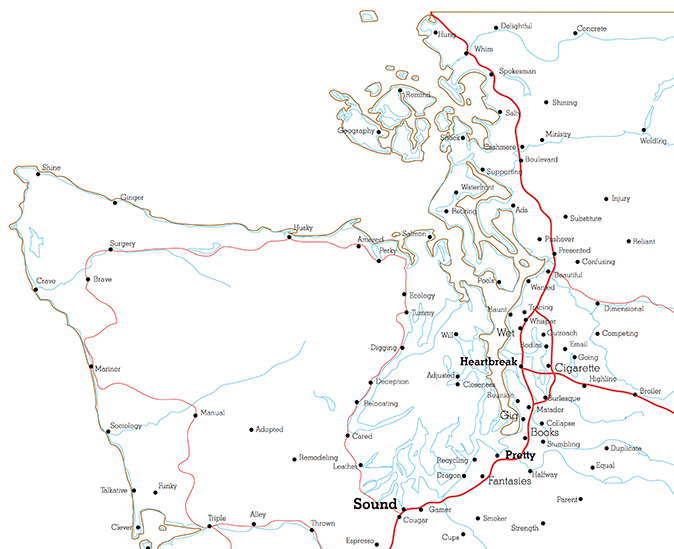1 Dating Web Site In Washington State
Get tips on meeting local singles with local online dating tips from LifeTips. Washington LLC entity search, s corporation search, c corporation search, corporation entity search, business name search, company name lookup, name search, business EIN, business name availability. We protect insurance consumers, the public interest, and our state’s economy through fair and efficient regulation of the insurance industry.
1 Dating Web Site In Washington State Login


1 Dating Web Site In Washington State Free
Often referred to by its full title, Washington State, to distinguish it from Washington, D.C., Washington[6] offers rugged coastline, deserts, forests, mountains, volcanoes, and hundreds of coastal islands to explore. The Cascade Mountains bisect the state, with the damp forested coastal areas to the west, and pineforests, deserts and irrigated farmland of the Columbia River Plateau to the east. Regions[edit]Washington regions
Cities[edit]There are many cities in Washington; these are some of the more popular.
Other destinations[edit]
Itineraries Understand[edit]
Talk[edit]Most people in Washington speak English with a Pacific Northwest accent. This accent is considered very similar to general American. Washingtonians generally have little to no problem understanding different accents of the English language. Washington is the thirteenth most populated state, but by comparison has the fourth highest Asian population. You may be able to find a Japanese or Chinese speaker, especially in the Seattle area. There is also a large Hispanic population. In some small towns east of the Cascades more than 50% of households speak Spanish at home. Get in[edit]By Plane[edit]Seattle-Tacoma International Airport, (IATA: SEA), called 'SeaTac' by locals, connects Seattle to all regions of the world, with especially frequent transpacific routes. Competition is heavy on busy San Francisco Bay Area and Southern California routes. Non-stops to the following countries: Canada, China, United Arab Emirates, France, Germany, Iceland, Japan, South Korea, Mexico, Netherlands, Taiwan, and the UK. Transfers are required from the Caribbean and Central and South America. Spokane International Airport, (IATA: GEG). Most flights go to Seattle, Portland (Oregon), Boise, Oakland (across from San Francisco), Salt Lake City, Los Angeles, Denver, Phoenix and Minneapolis. Seasonal flights to Chicago. Portland International Airport, (IATA: PDX) is just one mile across the state line in Oregon from Vancouver. For Southwest Washington (i.e. anything south of Chehalis along I-5 exit 77) this is the (next) nearest major airport. One daily non-stop from Tokyo, Amsterdam, Calgary and Guadalajara. Plans are underway to include additional flights to Los Cabos, Germany and Iceland with additional airlines. Vancouver International Airport (IATA: YVR) is in Canada 27 miles (44 km) from the border in Blaine/Surrey which is the border crossing to the USA from Canada. You will need the proper travel documents to (re)enter Canada and the U.S. to cross the border. For U.S. residents, going through customs twice probably isn't worth it unless you also want to visit Vancouver so the next nearest American airport is in Bellingham (see below). For Canadians wanting to go to the San Juan Islands it may be the best choice. There are also direct international flights to/from Europe, Mexico, Cuba, Australia, and Asia. For travel across Canada the total airfare may come out cheaper for one to cross into the United States by Greyhound or by another bus line, fly across the North American continent and go back up into Canada on another bus, then fly across Canada as Air Canada has a near monopoly on domestic travel. For, example to get from Toronto to Vancouver one may take a bus from Toronto to Buffalo, fly across the United States to Seattle and continue on another bus to Vancouver. Bellingham International Airport (IATA: BLI) is a regional airport about 90 miles north of Seattle and 60 miles south of Vancouver, Canada. Allegiant and Alaska Airlines have jet service to Las Vegas, Los Angeles, Oakland, Mesa (near Phoenix), San Diego, Honolulu and Palm Springs (seasonal). There are many shorter flights (mostly to Seattle) with turboprop aircraft. Tri-Cities Airport (IATA: PSC) is a commercial airport located 2 miles northwest of the city of Pasco and is the third largest commercial air terminal in the State of Washington. Flights go to Seattle, San Francisco, Los Angeles, Las Vegas, Mesa (near Phoenix), Salt Lake City, Denver, and Minneapolis (seasonal). Commuter Airports[edit]Horizon Air (which links to Alaska Air) has flights to five small cites in or near Washington State with infrequent daily service to Seattle-Tacoma. Lewiston, Idaho (next to Clarkston, Washington) (IATA: LWS) Seattle-Tacoma Pullman (IATA: PUW) Seattle-Tacoma Walla Walla (IATA: ALW) Seattle-Tacoma, or Portland via Eastern Oregon Regional Airport (IATA:PDT) in nearby Pendleton Wenatchee (IATA: EAT) Seattle-Tacoma, Portland (1 stop) Yakima (IATA: YKM) Seattle-Tacoma, Portland By train[edit]Amtrak [10] offers several ways to enter and travel throughout Washington by train:
For more information, see Amtrak's website, Wikitravel's article Rail travel in the United States, or the Wikipedia pages on each of this train services. By car[edit]From British Columbia[edit]Interstate 5 and the Peace Arch[14] crossing is the main land port-of-entry to Washington from Canada. However this is only one of five land crossing points between the Lower Mainland region of BC and the Northwest Cascades region of Washington. See the Get in — by car section of Northwest Cascades region article for details. From Oregon[edit]Interstate 5 (and Interstate 205) provide access from the greater Portland area. Interstate 82 / US 395 provides access from eastern Oregon to the tri-cities area of Eastern Washington. For a more scenic entry, try taking US Route 101 along the Washington and Oregon coast, but be aware for the numerous speed traps in the small cities. From Idaho[edit]Interstate 90 is the main route in via Coeur D'Alene, but US 2 provides access to the northern parts of Idaho and Washington. By bus[edit]Greyhound[15] has a number of bus stations throughout the state in metropolitan areas as well as the smaller micropolitan areas by way of the main interstate highways (5, 82 & 90). Passengers transfer buses in Missoula, MT; Portland, Seattle, Salt Lake City or Sacramento to get to where they're going. Get around[edit]To explore most of Washington (outside of main cities), you will generally need a car because there is very little public transportation, especially to more remote locations. By plane[edit]Most people get around the state by private automobile or buses but flying is still available if you're in a hurry to get there. Intrastate service is only offered by Alaska Airlines (Seattle, Portland and various destinations in the state) and Delta (Seattle, Portland & Spokane). By car[edit]Washington's road network is well-maintained and cars are the quickest way to travel around the state. The main freeways are I-5, running along the west side of Washington through many of Western Washington's population centers. I-90, running east of Seattle to Ellensburg and Spokane, and I-82, which starts at I-90 near Ellensburg and heads southeast through Yakima and Kennewick. Other US highways and WA state routes access all parts of the state. Rental-car agencies can be found in the larger cities. All of the state's major east-west highways cross over the Cascade Mountains, which are subject to closure, delays, and studded tire or chain requirements in wintertime. In severe weather, it may be better to use I-84 just across the border in Oregon. This route goes through the relatively low elevation of the Columbia River Basin. On rare occasion, I-84 may also have weather-related problems where it passes north of Mount Hood. A 20-mile detour on Washington State Hwy 14 is available between I-84 Exit #44 Bridge of the Gods, and Exit #64 Hood River Bridge. Both have a small toll. In urban areas (especially in Seattle) getting around by bus is fine but for most places, especially in small towns and in rural areas having driving is a must as (local) bus services are limited. By bus[edit]
By ferry[edit]Washington State Ferries[23] is the largest in the country. It has routes across Puget Sound and to Bainbridge, Vashon, Whidbey and the San Juan Islands. Inland, the state also offers some free ferries across the Columbia River. There are also some county-run ferries to smaller destinations such as to Anderson Island and Guemes Island. Many ferry destinations are not islands without a bridge, but peninsulas where going by land would involve a very long detour. The most extreme example of this is the Port Townsend -- Keystone route on State Hwy 20. Only five and a half miles via the ferry, becomes a whopping 217 miles (354 km) traveling by car! By train[edit]Getting around by train on Amtrak [24] is likely to be quite a hassle, especially with infrequent departures, slow travel times, inconvenient schedules and limited routes. For those who still wish to take trains to get around Washington, these are the main routes:
For more information, see Amtrak's website, Wikitravel's article Rail travel in the United States, or the Wikipedia pages on each of this train services. See[edit][add listing]Mt. Rainier and Mt. St. Helens Do[edit][add listing]
Eat[edit][add listing]Washington state is a great place for seafood, with salmon in particular being a specialty. Drink[edit][add listing]As with almost everywhere else in the U.S., the legal drinking and purchasing age of alcoholic beverages is 21. And as with most states, Washington uses loopholes in the federal law to allow underage drinking. Underage drinking of alcohol is allowed on private non-alcohol selling premises with parental presence and consent. Underage drinking is allowed for religious and medical purposes. Anyone under the age of 21 shall not be prosecuted for underage drinking if the underage drinker is succumbed to alcohol poisoning and is in need of medical assistance, but for obvious safety reasons this method is not recommended.[29] Specialty Coffee[edit]High quality Arabica coffee beans roasted with greater emphasis on taste and freshness, brewed with dripped water or 'espresso' steam) arguably has its birthplace here. Starbucks and Tully's are apparent brands that most associate specialty coffee with Seattle. However, many small local companies are the ones that have paved the way (and continue to do so) in pioneering the specialty coffee industry. When you visit Seattle, be sure to check out these renowned coffee roasters (in no particular order):
Wine and Microbrew Beers[edit]Washington is also the home to well-crafted local wines [30] and 'microbrewery' beers. Respect[edit]The western part of the state tend to be more tolerant to the LGBT group than the eastern part which is more conservative. Washington has a large Asian population that is concentrated mostly in the western part of the state. Some understanding of the corresponding customs and culture may serve you well in these areas. Also, do not assume that no one around you speaks English (chances are they do, so watch what you say). Do not litter along the freeways or highways. The fines for littering can range from several hundred to several thousand dollars depending on the scenario. It is an offense that the state takes VERY seriously. If you are caught in the act you will know what the state means by the 'Litter and It Will Hurt' signs which frequently decorate its roadways. Stay healthy[edit]Disease[edit]Like many western states, Washington State has had cases of hantaviral pulmonary syndrome, 41 confirmed cases in the state since 1993. Realistically, however, hantavirus is of very little concern to the traveler; but sensible precautions should be applied. Do NOT venture in a wild animal's den or handle any dead animals; particularly rodents, as rodents seem to be the primary vector of the illness. There is no cure for the disease, treatment mainly consists of supportive therapies. The main defense against the virus is prevention.
Stay safe[edit]Law Enforcement[edit]Law enforcement in the state is under control of the Washington State Patrol. Winter Weather and Avalanches[edit]If driving in eastern Washington Cascade Mountains which divide the state into halves snow accumlations can occur from early fall through late spring. Avalanches can be dangerous and the road conditions can be bad at times. Washington Department of Transportation does shut down roadways that goes through the Cascade mountains during winter seasons due to increase in snow and lack of snow removal equipment and emergency services. I-90 interstate around the pass is usually closed when the weather condition is severe and impedes traffic and is also closed for avalanche control. Mountain passes are sometimes closed for avalanche control and may affect travel plans, especially along I-90 from Yakima to Seattle. Check the Washington State Department of Transportation website [32] for information regarding Avalanche control. If going into the mountains during winter and early spring months, refer to the Northwest Weather and Avalanche Center website [33] for information regarding the current avalanche dangers throughout the Cascade region of the state. Crime[edit]Much like any state in the United States, Washington is generally safe provided that you use common sense and keep your wits about you. Certain areas of Seattle, Spokane, Tacoma, and Yakima can become seedy after dark and it is therefore advised that one avoid being out alone very late at night; this is especially true in unlit places where you are an easy target for any crime or other illegal activity. Parks in the urban areas of western Washington are not places to be at night unless you are seeking trouble. Stay to the main tourist areas of the state during the day and you will have a great visit. If you find yourself in an emergency situation (of any kind), dial 911 on your phone. Deserts[edit]East of the Cascade Mountains, the state's terrain begins to turn into desert and temperatures often exceed 100 degrees Fahrenheit in regions such as the Yakima Valley , Eastern Washington Desert and the Columbia River Plateau. If are planning on hiking into these locations, follow desert survival guidelines. Be sure to take plenty of water (at least one gallon per person, per day), sunscreen and wear light clothing. Let someone know where you are going and when you expect to get return. Also, it is best to hike during the earlier part of the day, as thunderstorms tend to develop suddenly during the afternoon. In the event you encounter inclement weather conditions, seek high ground immediately! Thunderstorms can cause flash flooding in canyons and other low laying areas. Landslides[edit]During the winter months, the western side of the state often receives significant rainfall which soften the grounds to such a point that landslides sometimes occur. Be especially alert when driving. Embankments along roadsides are particularly susceptible to landslides. Watch the road for collapsed pavement, mud, fallen rocks, and other indications of possible landslides or debris flows. If you encounter a landslide, LEAVE the area immediately if it is safe to do so and call the local fire, police or public works department Volcanoes[edit]Volcano safety is, to put it mildly, a controversial subject; see the article on Volcanoes (and, particularly, its discussion page) for some of the issues. Washington state is home to five major, ACTIVE volcanoes, plus one just across the border in Oregon: Mount St. Helens (1980), Mount Rainier (1894) (which is considered to be one of the most dangerous volcanoes in the world), Mount Baker (1880), Mount Hood, Oregon (1866), Glacier Peak (c. 1700), and Mount Adams (c. 550 B.C.). The majority of these are considered to be tourist destinations, particularly Rainier and St. Helens. If planning to visit one of these locations, FOLLOW the policy regarding any road and/or trail closures that at first glance may appear unnecessarily conservative -- but it is not. Believe it. The closures aren't there simply to inconvenience and irritate you. If a trail is closed due to eruptive hazard, stay off the trail. Marijuana[edit]Warning to anyone who is a non-U.S. citizen traveling from Canada. Even though Cannabis is now legal in the State, U.S. Border guards still obey federal law, where Marijuana is still illegal, so anyone trying to cross the border to the U.S. who discloses plans to try cannabis in the state could be denied entry into the U.S. or barred entry indefinitely. Guards will still be allowed to ask travelers whether they plan to buy legal marijuana. The U.S. department of justice allows Indian Reservations to regulate cannabis on their land. Because of this, Some Indian Reservations in the state may not allow cannabis on their land, such as the Yakama Nation, located in southern Washington. Bringing cannabis into any reservation that doesn't allow it will have indian reservation and federal law applied. Get out[edit]
| |||||||||||||||||||||||||||||||||

1 Dating Website In Washington State Usa
Twins can make an important contribution to research. You are eligible to participate in the Washington State Twin Registry if both you and your co-twin agree to participate. If you are eligible, you and your co-twin will be asked to complete a brief questionnaire. You may be contacted to take part in specific studies. Participation in these studies is voluntary.

Did you or your twin already receive an invitation to join?
1 Dating Website In Washington State 2017
The invitation sent by email or snail mail contains the link to complete the questionnaire online. Please do not use this form, as we already have your information. If you lost the link and/or your ID number, please call the Twin Registry at 1.833.432.8720 or email us at ws.twinregistry@wsu.edu.
Under 18 or a parent of twins? Click here.

To receive an invitation to join the Twin Registry, please complete the following form. We will send an email with a link to complete the enrollment survey. We must receive a survey from both you and your twin to enroll you into the Registry. For more information, please call the Twin Registry at 1.833.432.8720 or email us at ws.twinregistry@wsu.edu.